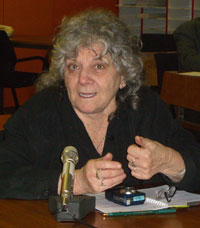Nobel Prize in Chemistry for Ada Yonath laureate of L’OREAL-UNESCO award
"for studies of the structure and function of the ribosome"

- © UNESCO/P. Chiang-Joo
- Prof. Ada Yonath
Born in 1939 in Jerusalem, Israel. Ph.D. in X-ray Crystallography in 1968 from the Weizmann Institute of Science, Israel. Martin S. and Helen Kimmel Professor of Structural Biology and Director of Helen & Milton A. Kimmelman Center for Biomolecular Structure & Assembly, both at Weizmann Institute of Science, Rehovot, Israel.
She has succeeded in determining the structure of ribosomes and the way in which antibiotics disrupt these. Ribosomes are responsible for the production of all proteins in living cells, including those of humans, plants and bacteria. If the work of the ribosome is impeded, the cell dies. Ribosomes are a key target for antibiotics, as antibiotics are able to attack the ribosomal activity of harmful bacteria while leaving human ribosomes untouched.
The fact that bacteria are becoming resistant to antibiotics is a serious public health concern. Prof. Yonath's research has also revealed the precise modes of action of over 20 different antibiotics targeting bacterial ribosomes, shedding light on how bacteria become resistant to antibiotics. This knowledge can be applied to improving the ability of antibiotics to target ribosomes of pathogens, helping to combat the problem of resistance.
This year's Nobel Prize in Chemistry awards Venkatraman Ramakrishnan, Thomas A. Steitz and Ada E. Yonath for having showed what the ribosome looks like and how it functions at the atomic level. All three have used a method called X-ray crystallography to map the position for each and every one of the hundreds of thousands of atoms that make up the ribosome.
The Nobel Prize in Chemistry for 2009 awards studies of one of life's core processes: the ribosome's translation of DNA information into life.
Inside every cell in all organisms, there are DNA molecules. They contain the blueprints for how a human being, a plant or a bacterium, looks and functions. But the DNA molecule is passive. If there was nothing else, there would be no life.
Related links:
:: The key to life at the atomic level [.pdf]
:: UNESCO "Women in Science" Programme (More)
:: The UNESCO Courrier (More)
:: A World of Science, Vol. 6, N°2 (April - June 2008) p.10 [.pdf]
- Source:UNESCO SC
- 07-10-2009

